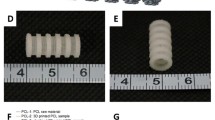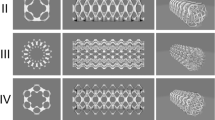Abstract
Background:
Several types of three-dimensional (3D)-printed tracheal scaffolds have been reported. Nonetheless, most of these studies concentrated only on application of the final product to an in vivo animal study and could not show the effects of various 3D printing methods, materials, or parameters for creation of an optimal 3D-printed tracheal scaffold. The purpose of this study was to characterize polycaprolactone (PCL) tracheal scaffolds 3D-printed by the 4-axis fused deposition modeling (FDM) method and determine the differences in the scaffold depending on the additive manufacturing method.
Methods:
The standard 3D trachea model for FDM was applied to a 4-axis FDM scaffold and conventional FDM scaffold. The scaffold morphology, mechanical properties, porosity, and cytotoxicity were evaluated. Scaffolds were implanted into a 7 × 10-mm artificial tracheal defect in rabbits. Four and 8 weeks after the operation, the reconstructed sites were evaluated by bronchoscopic, radiological, and histological analyses.
Results:
The 4-axis FDM provided greater dimensional accuracy and was significantly closer to CAD software-based designs with a predefined pore size and pore interconnectivity as compared to the conventional scaffold. The 4-axis tracheal scaffold showed superior mechanical properties.
Conclusion:
We suggest that the 4-axis FDM process is more suitable for the development of an accurate and mechanically superior trachea scaffold.








Similar content being viewed by others
References
Ott LM, Zabel TA, Walker NK, Farris AL, Chakroff JT, Ohst DG, et al. Mechanical evaluation of gradient electrospun scaffolds with 3D printed ring reinforcements for tracheal defect repair. Biomed Mater. 2016;11:25020.
Lee DY, Park SA, Lee SJ, Kim TH, Oh SH, Lee JH, et al. Segmental tracheal reconstruction by 3D-printed scaffold: pivotal role of asymmetrically porous membrane. Laryngoscope. 2016;126:E304–9.
Chang JW, Park SA, Park JK, Choi JW, Kim YS, Shin YS, et al. Tissue-engineered tracheal reconstruction using three-dimensionally printed artificial tracheal graft: preliminary report. Artif Organs. 2014;38:E95–105.
Atala A, Yoo JJ. Essentials of 3D biofabrication and translation. Amsterdam: Elsevier Inc.; 2015. p. 43–59.
Jung SY, Lee SJ, Kim HY, Park HS, Wang Z, Kim HJ, et al. 3D printed polyurethane prosthesis for partial tracheal reconstruction: a pilot animal study. Biofabrication. 2016;8:45015.
Park JH, Hong JM, Ju YM, Jung JW, Kang HW, Lee SJ, et al. A novel tissue-engineered trachea with a mechanical behavior similar to native trachea. Biomaterials. 2015;62:106–15.
Mäkitie AA, Korpela J, Elomaa L, Reivonen M, Kokkari A, Malin M, et al. Novel additive manufactured scaffolds for tissue engineered trachea research. Acta Otolaryngol. 2013;133:412–7.
Lee JH, Park HS, Oh SH, Lee JH, Kim JR, Kim HJ, et al. Triple-layered polyurethane prosthesis with wrinkles for repairing partial tracheal defects. Laryngoscope. 2014;124:2757–63.
Farzadi A, Solati-Hashjin M, Asadi-Eydivand M, Abu Osman NA. Effect of layer thickness and printing orientation on mechanical properties and dimensional accuracy of 3D printed porous samples for bone tissue engineering. PLoS One. 2014;9:e108252.
Park SA, Lee SJ, Lim KS, Bae IH, Lee JH, Kim WD, et al. In vivo evaluation and characterization of a bio-absorbable drug-coated stent fabricated using a 3D-printing system. Mater Lett. 2015;141:355–8.
Grutle ØK. 5-axis 3D printer. Master’s Thesis Autum, Department of Informatics, University of Oslo; 2015.
Kim SH, Park HS, Lee OJ, Chao JR, Park HJ, Lee JM, et al. Fabrication of duck’s feet collagen-silk hybrid biomaterial for tissue engineering. Int J Biol Macromol. 2016;85:442–50.
Zhang RY, Ma PX. Poly(alpha-hydroxyl acids)/hydroxyapatite porous composites for bone-tissue engineering. I. Preparation and morphology. J Biomed Mater Res. 1999;44:446–55.
Lv Q, Cao C, Zhang Y, Man X, Zhu H. The preparation of insoluble fibroin films induced by degummed fibroin or fibroin microspheres. J Mater Sci Mater Med. 2004;15:1193–7.
Lužanin O, Movrin D, Plančak M. Experimental investigation of extrusion speed and temperature effects on arithmetic mean surface roughness in FDM built specimens. J Technol Plast. 2013;38:179–90.
Sun H, Mei L, Song C, Cui X, Wang P. The in vivo degradation, absorption and excretion of PCL-based implant. Biomaterials. 2006;27:1735–40.
U.S. Department of Health and Human Services Food and Drug Administration, Center for Devices and Radiological Health, Center for Biologics Evaluation and Research. Technical considerations for additive manufactured medical devices—Guidance for Industry and Food and Drug Administration Staff, FDA. 2017. p. 1–31.
Acknowledgements
This research was supported by Hallym University Research Fund, and Grant (16172MFDS334) from the Ministry of Food and Drug Safety in 2016, Republic of Korea.
Author information
Authors and Affiliations
Corresponding author
Ethics declarations
Conflict of interest
The authors declare that they have no conflict of interest.
Ethical approval
This study was approved by the institutional review board of Hallym University (IRB 2016-64), Chuncheon, Korea.
Rights and permissions
About this article
Cite this article
Park, H.S., Park, H.J., Lee, J. et al. A 4-Axis Technique for Three-Dimensional Printing of an Artificial Trachea. Tissue Eng Regen Med 15, 415–425 (2018). https://doi.org/10.1007/s13770-018-0136-8
Received:
Revised:
Accepted:
Published:
Issue Date:
DOI: https://doi.org/10.1007/s13770-018-0136-8




